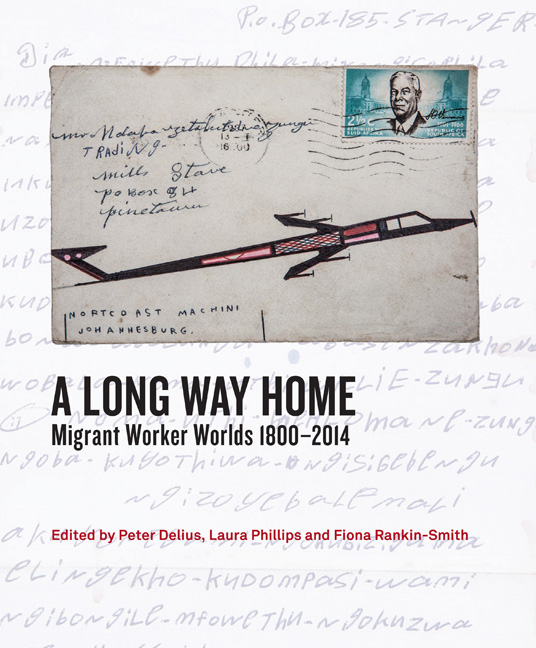Book contents
- Frontmatter
- Contents
- Acknowledgements
- Introduction: Highlighting Migrant Humanity
- Chapter 1 Ngezinyawo - Migrant Journeys
- Chapter 2 Slavery, Indenture and Migrant Labour: Maritime Immigration from Mozambique to the Cape, c.1780–1880
- Chapter 3 Walking 2 000 Kilometres to Work and Back: The Wandering Bassuto by Carl Richter
- Chapter 4 A Century of Migrancy from Mpondoland
- Chapter 5 The Migrant Kings of Zululand
- Chapter 6 The Art of Those Left Behind: Women, Beadwork and Bodies
- Chapter 7 The Illusion of Safety: Migrant Labour and Occupational Disease on South Africa's Gold Mines
- Chapter 8 ‘The Chinese Experiment’: Images from the Expansion of South Africas ‘Labour Empire’
- Chapter 9 ‘Stray Boys’: The Kruger National Park and Migrant Labour
- Chapter 10 Surviving Drought: Migrancy and the Homestead Economy
- Chapter 11 Migrants from Zebediela and Shifting Identities on the Rand, 1930s–1970s
- Chapter 12 Verwoerd's Oxen: Performing Labour Migrancy in Southern Africa
- Chapter 13 ‘Give My Regards to Everyone at Home Including Those I No Longer Remember’: The Journey of Tito Zungu's Envelopes
- Chapter 14 Sophie and the City: Womanhood, Labour and Migrancy
- Chapter 15 Bungityala
- Chapter 16 Migrants: Vanguard of the Worker's Struggles?
- Chapter 17 Debt or Savings? Of Migrants, Mines and Money
- Chapter 18 Post-Apartheid Migrancy and the Life of a Pondo Mineworker
- Notes on Contributors
- List of Figures and Tables
- Index
Chapter 16 - Migrants: Vanguard of the Worker's Struggles?
Published online by Cambridge University Press: 04 July 2018
- Frontmatter
- Contents
- Acknowledgements
- Introduction: Highlighting Migrant Humanity
- Chapter 1 Ngezinyawo - Migrant Journeys
- Chapter 2 Slavery, Indenture and Migrant Labour: Maritime Immigration from Mozambique to the Cape, c.1780–1880
- Chapter 3 Walking 2 000 Kilometres to Work and Back: The Wandering Bassuto by Carl Richter
- Chapter 4 A Century of Migrancy from Mpondoland
- Chapter 5 The Migrant Kings of Zululand
- Chapter 6 The Art of Those Left Behind: Women, Beadwork and Bodies
- Chapter 7 The Illusion of Safety: Migrant Labour and Occupational Disease on South Africa's Gold Mines
- Chapter 8 ‘The Chinese Experiment’: Images from the Expansion of South Africas ‘Labour Empire’
- Chapter 9 ‘Stray Boys’: The Kruger National Park and Migrant Labour
- Chapter 10 Surviving Drought: Migrancy and the Homestead Economy
- Chapter 11 Migrants from Zebediela and Shifting Identities on the Rand, 1930s–1970s
- Chapter 12 Verwoerd's Oxen: Performing Labour Migrancy in Southern Africa
- Chapter 13 ‘Give My Regards to Everyone at Home Including Those I No Longer Remember’: The Journey of Tito Zungu's Envelopes
- Chapter 14 Sophie and the City: Womanhood, Labour and Migrancy
- Chapter 15 Bungityala
- Chapter 16 Migrants: Vanguard of the Worker's Struggles?
- Chapter 17 Debt or Savings? Of Migrants, Mines and Money
- Chapter 18 Post-Apartheid Migrancy and the Life of a Pondo Mineworker
- Notes on Contributors
- List of Figures and Tables
- Index
Summary
Benoni, Boksburg, Springs, Egoli, we make you rich. We hostel people make you rich. You send us back home to die with empty pockets, empty dreams and dust in our lungs, chopped-off hands and machines grinding in our brain.
Trade unions have historically played a critical role in the struggle for emancipation in South Africa. Despite severe legal restrictions and repression, black workers formed unions to fight for better conditions in workplaces and, at key moments, also against the system of white minority rule. Often these unions were influenced by socialist ideas, causing them to be in the forefront of the struggle against capitalism. At different times in the twentieth century, black trade unions posed a serious challenge to dominant class relations at the point of production, which invariably affected the entire political establishment. Migrant workers featured prominently in these struggles.
These workers, who were overwhelmingly African men, have historically constituted the backbone of South Africa's labour force. Predominantly concentrated in the mining sector from the late nineteenth century, migrants were also employed in increasing numbers in industry and municipalities as the secondary economy and urban areas expanded in the twentieth century. Their lives were ruled by a migrant labour system characterised by restrictive labour controls and relatively low wages, which entrapped them on the margins of society. As the modern economy expanded and concomitantly the demand for labour, the number of migrant men spending time in urban areas for extended periods also registered sharp increases. Most of them found life in the towns, which oscillated between lowpaid toil in the mines or factories and the dreary (and increasingly derelict) hostels, deeply alienating. But, as Peter Delius has explained, migrants ‘did not allow themselves to be transformed into atomised economic units tossed to and fro in the swirling currents of market forces’. On the contrary, they constantly struggled against various aspects of their exploitation.
Migrant workers devised various responses to their circumstances in the urban economy, from mutual support to collective resistance. They created associations, invariably born from rural-based networks, which while providing support in the harsh urban environment and maintaining links to rural homes, also engendered solidarity in workplaces.
- Type
- Chapter
- Information
- A Long Way HomeMigrant Worker Worlds 1800–2014, pp. 224 - 240Publisher: Wits University PressPrint publication year: 2014

